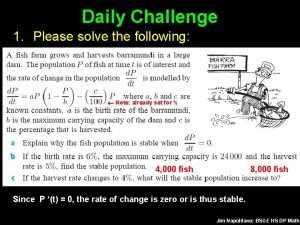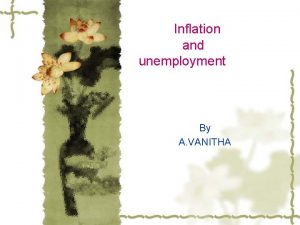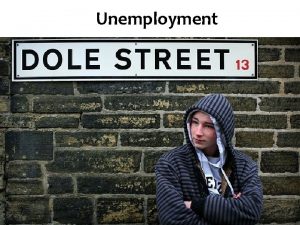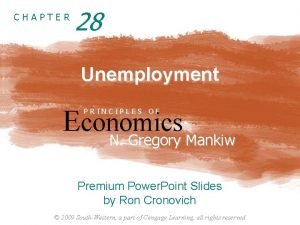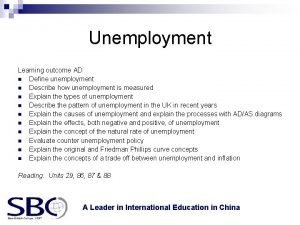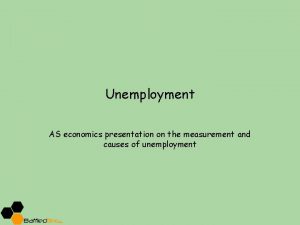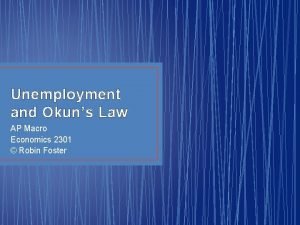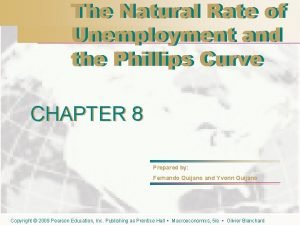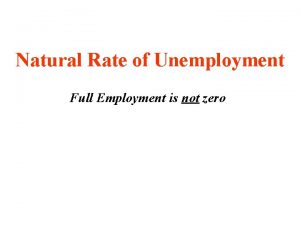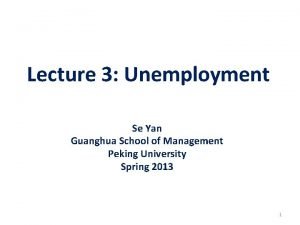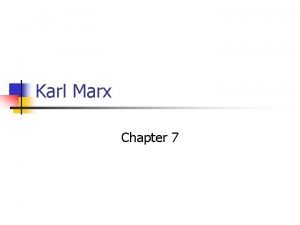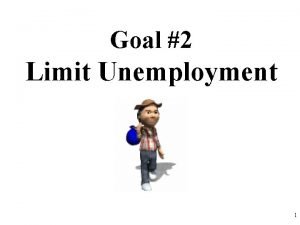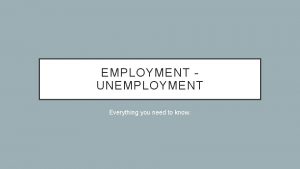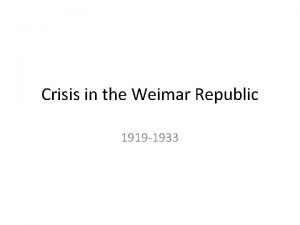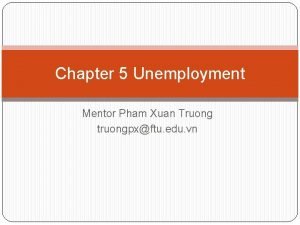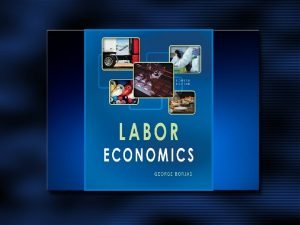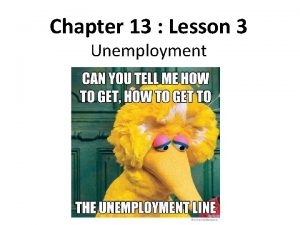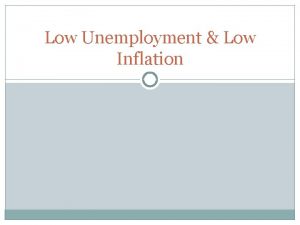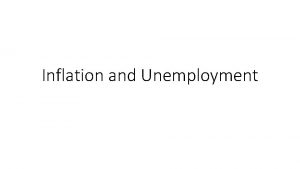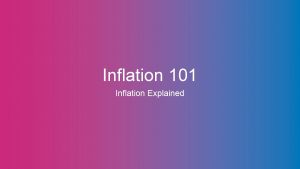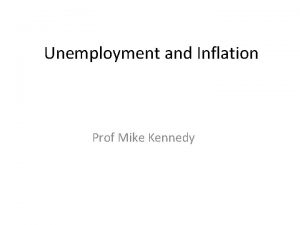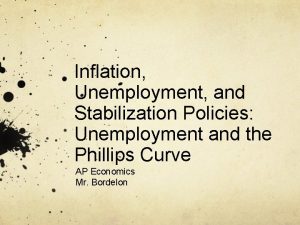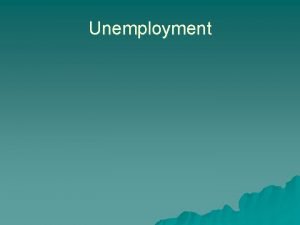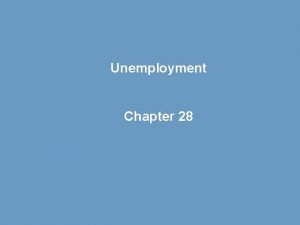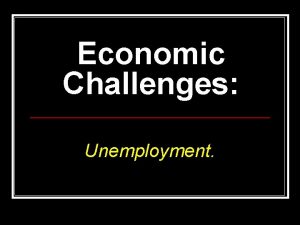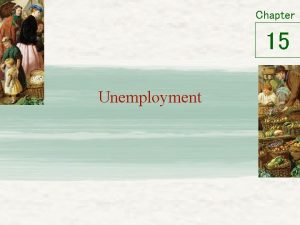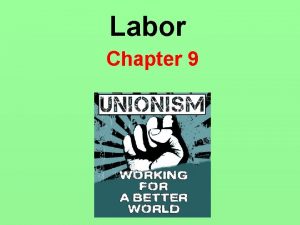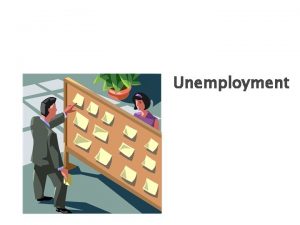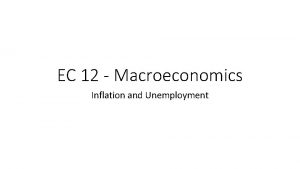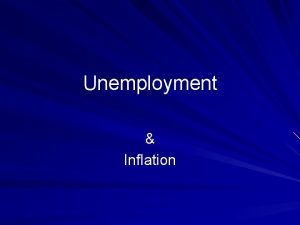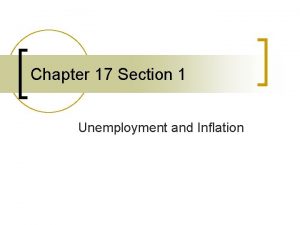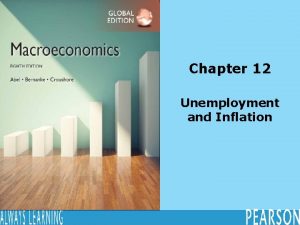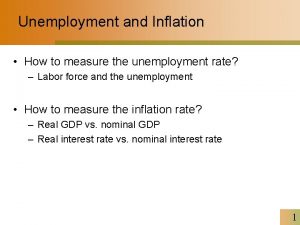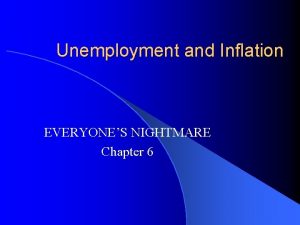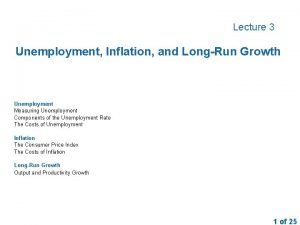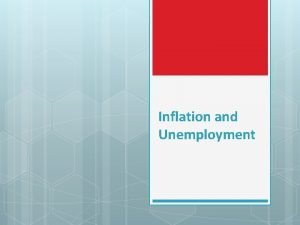Inflation Part 2 and Unemployment Inflation terms revisited








































- Slides: 40

Inflation Part 2 and Unemployment

Inflation terms revisited: • Inflation: Dollar is losing value • Deflation: Dollar is gaining value • Disinflation: Slowing of the rate the dollar is losing value • Hyperinflation: Inflation out of control • Stagflation: Stagnation + Inflation = sitting at high inflation and unemployment

Hyperinflation

Germany and Hyperinflation (P = 100 in 1913) Date Value of Price Index Jan 1921 1400 Jan 1922 3700 Jan 1923 278, 500 Aug 1923 94, 400, 000 Sept 1923 (state of emergency declared) 2, 390, 000 Oct 1923 (failed Nazi coup 11/9/23) 709, 600, 000 Nov 15, 1923 (converted to new denomination) 75, 000, 000

Anticipated Inflation • Anticipated: Expected; consumers and businesses plan for it

Indexes • CPI= Consumer Price Index • Based on basket of goods from 1983 (between ‘ 82 -’ 83) • GDP Deflator • Based on general price index • = current basket of goods current price/current basket of goods at real price X 100 • PPI= Producer Price Index • Based on change in selling prices received by producers

Indexes continued • PCE= Personal Consumption Expenditure • Based on Consumer piece of the GDP

Unexpected Inflation Causes: Push • Causes are up for debate • Cost-Push: • Wages are exceeding productivity • Administered Prices • Market Structure • Invisible Handshake • 3 rd Party Payment Systems • Trade Restrictions

Unexpected Inflation Causes: Pull • Demand-Pull: • Government Deficit Spending • Transfer Payments • Automatic Stabilizers • Politics


Unanticipated Winners • High Incomes • Debtors • Hard assets • Exporters

Unanticipated Losers • Fixed incomes • Creditors • Importers • Consumers • “shoe leather costs” • Producers • Wealth Management


Sample problems: calculate Real Interest Rate End of Year CPI Nominal Real Interest Rate 1 100 2 110 15% 3 120 13% 4 115 8%

Labor and Unemployment • Working Age Population • Labor Force Participation Rate: Labor Force/Working Age Pop X 100 • Employment-Population Ratio = Total Employed/Total Population

Unemployment • Unemployment Rate = unemployed/labor force population X 100 • Who is considered “Unemployed”

Unemployment continued • Not in labor force if…

Types of unemployment • Frictional: choice, not a “fit” • Structural: change in firm/tech/marketing • Cyclical: business cycle changes • Seasonal:

Who is not counted as “unemployed”? • Discouraged • Marginally attached

Other problems with unemployment measurements • Dishonest workers • Involuntary parttime workers Source: BLS

* Source: BLS

Costs of unemployment: Economic • Economic: • Opportunity cost • Okun’s Law • For every 1% increase in unemployment = 2 -3% decrease in output

Costs of Unemployment: beyond monetary • Broader impact: • Psychological and physical impacts • Discrimination

Unemployment disparity August 2007 (full employment) August 2011 (severe slump) Overall 4. 6% 9. 1% Whites 4. 2 8. 0 Hispanics 5. 5 11. 3 Blacks 7. 7 16. 7

Sample problem: Freedonia uses the same method to calculate unemployment as the BLS. Compute their unemployment rate below. Population 60, 000 Under 16 9000 Over 16 In military service 600 In hospitals 60 In prison 200 Worked 1 hr or more in previous week 46, 000 Searched for work in previous 4 weeks 2140 Did not work in previous week, but would like a job if offered 200

Freedonia problems continued • A. How large is Freedonia’s labor force? • B. How many discouraged workers live in Freedonia? • C. How are missing citizens (not all are accounted for in the chart) classified? What might they be doing? • D. How many of Freedonia’s citizens are not in the labor force?

What is full-employment? • Natural rate of unemployment is about 5% in the U. S. in a normally functioning economy • Frictional + structural unemployment/labor force X 100 = natural rate of employment • Full employment is ≠ 100% • Level of employment corresponds with natural rate • Excludes cyclical unemployment

Some is okay • Some unemployment is alright • Frictional unemployment: moving to better jobs; better “fits”

Calculate Wages with inflation • Real Wage = Nominal Wage in that Year/CPI in that year X 100 Real earnings in 1980: $269/week / CPI of 86. 3 X 100 = $312 Real earnings in 2010: $751/week/ CPI of 219. 2 X 100 = $343

Practice with wages Year Nominal weekly Earnings CPI Real Earnings (1983 $) 1980 $269 86. 3 $312 1985 $348 109. 3 $318 1990 $417 133. 8 $312 1995 $482 153. 5 $314 2000 $581 174. 0 $334 2005 $658 196. 8 $334 2010 $751 219. 2 $343

Calculate Inflation and Real Hourly Wage Rate Year CPI Inflation Rate Nominal Wage (nom CPI – real CPI/real CPI) Real Wage wage/CPI) 1 100 $10. 00 2 110 $12. 00 3 120 $13. 00 4 115 $12. 75 (nom

How does this all fit together? The business Cycle: Times of Prosperity

During Recession (2 consecutive quarters of declining GDP)

During Depression (depends on source – 4 – 8 quarters of declining GDP) • 47 Recessions and Depressions in U. S. History: Panic of 1785 Mid 1800 s Panic of 1857 1873 1893 Depression of 1907 Depression of 1920 -1 Great Depression 1929

During Recovery

Kondratieff Wave • Theory of Cycle of business cycles: pattern of 50 -60 yrs • Cycle of prosperity preceded by population increases (includes immigration) • Leads to high demand • Producers can’t keep up with demands • High inflation • High credit use • Each cycle grows better with higher and higher inflation • Inflation devalues the dollar • Government is overturned • Downward part of cycle • Poverty and depression

1945 1929


Theories for Business Cycle • Over-production theory • Under-Consumption theory • Monetary theory • Imbalance between saving and investment

More theories on the business cycle • Psychological Theory • War Theory • Sunspot, Weather, Crop Theories • Innovation Theory • Self-Generating Theory
 Math lesson
Math lesson Zhuoyue zhao
Zhuoyue zhao Relationship between inflation and unemployment
Relationship between inflation and unemployment Futa inflation meaning
Futa inflation meaning Polynomial classification
Polynomial classification Identify the terms and like terms in the expression. t+8+3t
Identify the terms and like terms in the expression. t+8+3t Objective of unemployment
Objective of unemployment Chapter 28 unemployment problems and applications answers
Chapter 28 unemployment problems and applications answers Aims and objectives of unemployment
Aims and objectives of unemployment Addition symbol
Addition symbol Unit ratio definition
Unit ratio definition Part part whole
Part part whole What is a technical description
What is a technical description Under bar layout
Under bar layout The phase of the moon you see depends on ______.
The phase of the moon you see depends on ______. Minitab adalah
Minitab adalah The 4 types of unemployment
The 4 types of unemployment Unemployment economic
Unemployment economic Types of unemployment
Types of unemployment Voluntary unemployment
Voluntary unemployment South africa unemployment rate by race
South africa unemployment rate by race Calculate inflation rate
Calculate inflation rate Unemployment
Unemployment Types of unemployment
Types of unemployment Factor of unemployment
Factor of unemployment Natural rate of unemployment
Natural rate of unemployment Unemployment ny
Unemployment ny Unemployment
Unemployment Paragraph about unemployment
Paragraph about unemployment Nairu
Nairu Seasonal unemployment example
Seasonal unemployment example Okun's law unemployment formula
Okun's law unemployment formula King lear historical context
King lear historical context Marx
Marx Unemployment examples
Unemployment examples Unemployment categories
Unemployment categories Weimar republic unemployment
Weimar republic unemployment Classical unemployment
Classical unemployment Unemployment
Unemployment Why are some types of unemployment unavoidable?
Why are some types of unemployment unavoidable? 4 types of unemployment
4 types of unemployment
